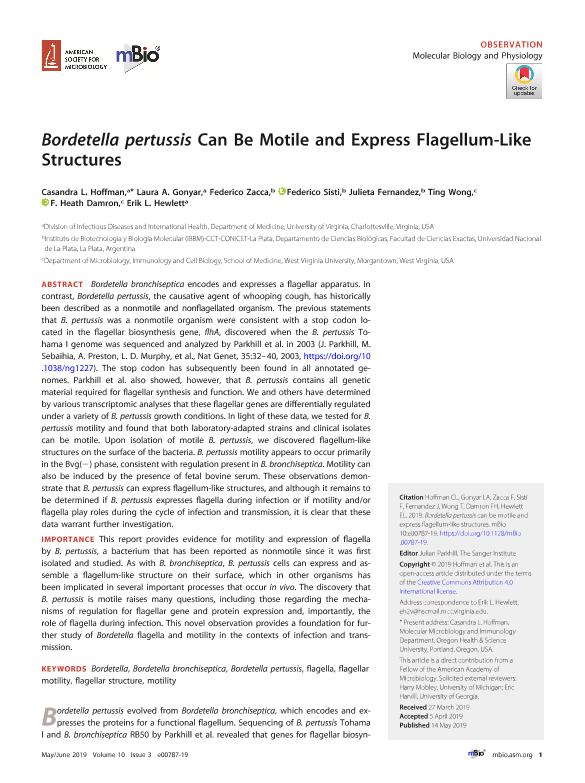Mostrar el registro sencillo del ítem
dc.contributor.author
Hoffman, Casandra L.
dc.contributor.author
Gonyar, Laura A.
dc.contributor.author
Zacca, Federico Hernán

dc.contributor.author
Sisti, Federico Bernardo

dc.contributor.author
Fernandez, Julieta

dc.contributor.author
Wong, Ting
dc.contributor.author
Damron, F. Heath
dc.contributor.author
Hewlett, Erik L.
dc.date.available
2022-02-08T22:15:27Z
dc.date.issued
2019-05-14
dc.identifier.citation
Hoffman, Casandra L.; Gonyar, Laura A.; Zacca, Federico Hernán; Sisti, Federico Bernardo; Fernandez, Julieta; et al.; Bordetella pertussis can be motile and express flagellum-like structures; American Society for Microbiology; mBio; 10; 3; 14-5-2019; 1-8
dc.identifier.issn
2161-2129
dc.identifier.uri
http://hdl.handle.net/11336/151616
dc.description.abstract
Bordetella bronchiseptica encodes and expresses a flagellar apparatus. In contrast, Bordetella pertussis, the causative agent of whooping cough, has historically been described as a nonmotile and nonflagellated organism. The previous statements that B. pertussis was a nonmotile organism were consistent with a stop codon located in the flagellar biosynthesis gene, flhA, discovered when the B. pertussis To-hama I genome was sequenced and analyzed by Parkhill et al. in 2003 (J. Parkhill, M. Sebaihia, A. Preston, L. D. Murphy, et al., Nat Genet, 35:32– 40, 2003, https://doi.org/10.1038/ng1227). The stop codon has subsequently been found in all annotated genomes. Parkhill et al. also showed, however, that B. pertussis contains all genetic material required for flagellar synthesis and function. We and others have determined by various transcriptomic analyses that these flagellar genes are differentially regulated under a variety of B. pertussis growth conditions. In light of these data, we tested for B. pertussis motility and found that both laboratory-adapted strains and clinical isolates can be motile. Upon isolation of motile B. pertussis, we discovered flagellum-like structures on the surface of the bacteria. B. pertussis motility appears to occur primarily in the Bvg(-) phase, consistent with regulation present in B. bronchiseptica. Motility can also be induced by the presence of fetal bovine serum. These observations demonstrate that B. pertussis can express flagellum-like structures, and although it remains to be determined if B. pertussis expresses flagella during infection or if motility and/or flagella play roles during the cycle of infection and transmission, it is clear that these data warrant further investigation. IMPORTANCE This report provides evidence for motility and expression of flagella by B. pertussis, a bacterium that has been reported as nonmotile since it was first isolated and studied. As with B. bronchiseptica, B. pertussis cells can express and assemble a flagellum-like structure on their surface, which in other organisms has been implicated in several important processes that occur in vivo. The discovery that B. pertussis is motile raises many questions, including those regarding the mechanisms of regulation for flagellar gene and protein expression and, importantly, the role of flagella during infection. This novel observation provides a foundation for further study of Bordetella flagella and motility in the contexts of infection and transmission.
dc.format
application/pdf
dc.language.iso
eng
dc.publisher
American Society for Microbiology

dc.rights
info:eu-repo/semantics/openAccess
dc.rights.uri
https://creativecommons.org/licenses/by/2.5/ar/
dc.subject
BORDETELLA
dc.subject
BORDETELLA BRONCHISEPTICA
dc.subject
BORDETELLA PERTUSSIS
dc.subject
FLAGELLA
dc.subject
FLAGELLAR MOTILITY
dc.subject
FLAGELLAR STRUCTURE
dc.subject
MOTILITY
dc.subject.classification
Biología Celular, Microbiología

dc.subject.classification
Ciencias Biológicas

dc.subject.classification
CIENCIAS NATURALES Y EXACTAS

dc.title
Bordetella pertussis can be motile and express flagellum-like structures
dc.type
info:eu-repo/semantics/article
dc.type
info:ar-repo/semantics/artículo
dc.type
info:eu-repo/semantics/publishedVersion
dc.date.updated
2020-11-25T16:44:09Z
dc.identifier.eissn
2150-7511
dc.journal.volume
10
dc.journal.number
3
dc.journal.pagination
1-8
dc.journal.pais
Estados Unidos

dc.description.fil
Fil: Hoffman, Casandra L.. University of Virginia; Estados Unidos
dc.description.fil
Fil: Gonyar, Laura A.. University of Virginia; Estados Unidos
dc.description.fil
Fil: Zacca, Federico Hernán. Consejo Nacional de Investigaciones Científicas y Técnicas. Centro Científico Tecnológico Conicet - La Plata. Instituto de Biotecnología y Biología Molecular. Universidad Nacional de La Plata. Facultad de Ciencias Exactas. Instituto de Biotecnología y Biología Molecular; Argentina
dc.description.fil
Fil: Sisti, Federico Bernardo. Consejo Nacional de Investigaciones Científicas y Técnicas. Centro Científico Tecnológico Conicet - La Plata. Instituto de Biotecnología y Biología Molecular. Universidad Nacional de La Plata. Facultad de Ciencias Exactas. Instituto de Biotecnología y Biología Molecular; Argentina
dc.description.fil
Fil: Fernandez, Julieta. Consejo Nacional de Investigaciones Científicas y Técnicas. Centro Científico Tecnológico Conicet - La Plata. Instituto de Biotecnología y Biología Molecular. Universidad Nacional de La Plata. Facultad de Ciencias Exactas. Instituto de Biotecnología y Biología Molecular; Argentina
dc.description.fil
Fil: Wong, Ting. West Virginia University; Estados Unidos
dc.description.fil
Fil: Damron, F. Heath. West Virginia University; Estados Unidos
dc.description.fil
Fil: Hewlett, Erik L.. University of Virginia; Estados Unidos
dc.journal.title
mBio
dc.relation.alternativeid
info:eu-repo/semantics/altIdentifier/doi/http://dx.doi.org/10.1128/mBio.00787-19
dc.relation.alternativeid
info:eu-repo/semantics/altIdentifier/url/https://journals.asm.org/doi/10.1128/mBio.00787-19
Archivos asociados
